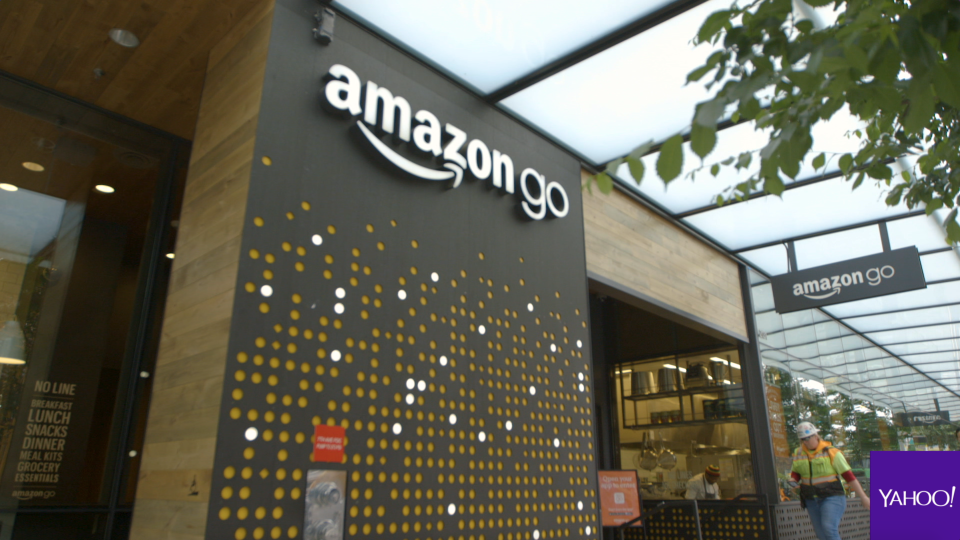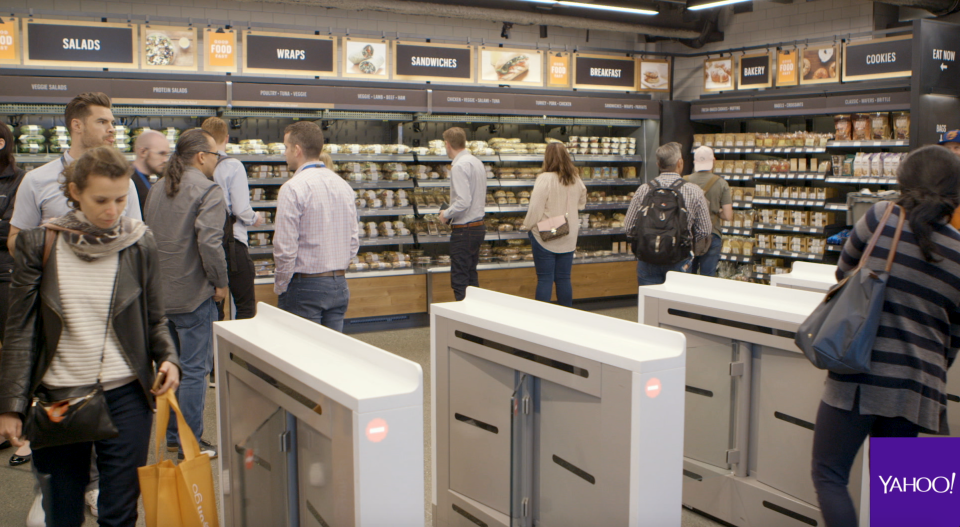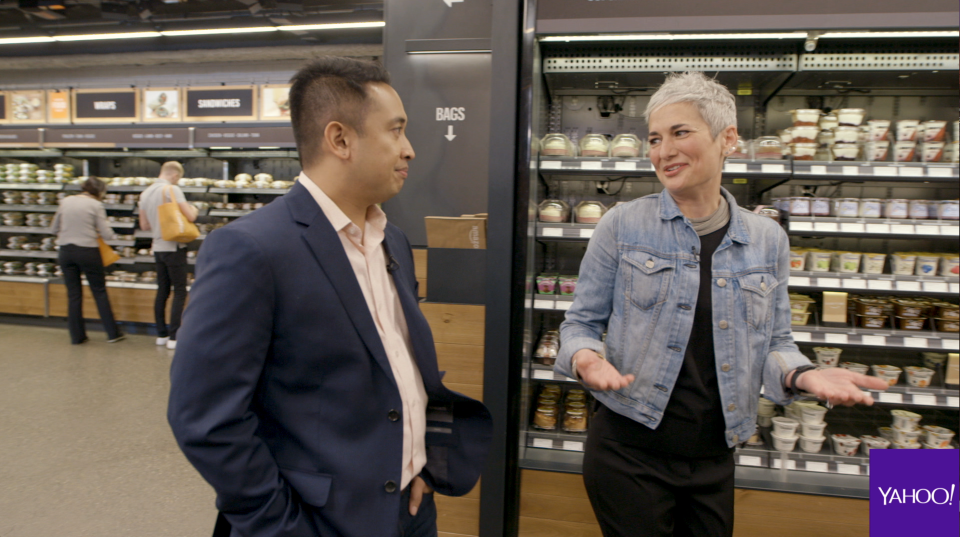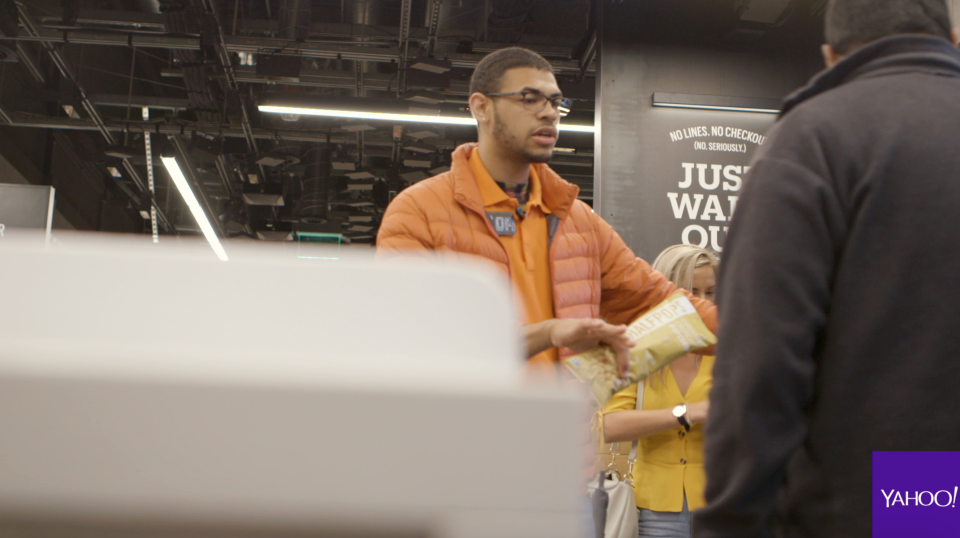Amazon Go chief: We got rid of a 'not great' thing about physical retail
Amazon’s (AMZN) cashier-free grocery store is coming to San Francisco and Chicago, and one of the biggest differences shoppers there can expect is an emphasis on foods from local businesses, the Seattle tech giant tells Yahoo Finance.
“Here in Seattle, we have a lot of things from local bakeries and local food purveyors, and that will vary in every city,” Amazon VP of Amazon Go Gianna Puerini explains to Yahoo Finance. “Some things won’t. We’ll have Coke in all the stores and things like that. But I think the biggest difference that we focus on as we get ready for that is what local selection will delight customers the most.”
While Puerini would not specify whether the upcoming Amazon Go stores will be similar in size to the Seattle location — the Chicago store could be roughly one-third the size, according to The Seattle Times — she added that Amazon was purposeful in keeping its pilot store on the smaller side.
One thing that doesn’t take up room in Amazon Go stores? Lines.
“When a small group of us sat down and brainstormed [Amazon Go], we knew there were all these great things about physical retail, but what’s not great?” Puerini explains. “And we unanimously said, well, standing in line is an issue. That’s not the most value-add part of my experience. I don’t love that. So we asked ourselves, ‘What could happen if we could get rid of that?”
Keeping Amazon Go ‘compact’

“We wanted to keep it reasonably compact because that’s more convenient,” Puerini explains. “You learn it very quickly, and you know where things are. If you find your favorites, you can beeline right to them and get out the door.”
While Amazon hasn’t disclosed Amazon Go’s sales figures since it opened in January, a steady stream of customers flowed in and out during our four-hour visit to the Seattle store this week, with a heavy crowd during lunchtime.
Regardless, sales must be encouraging enough for the company to move forward with its expansion into Chicago and San Francisco. Much of that has do with the premise of Amazon Go: a cashier-free store that uses a combination of cameras, computer vision and machine learning so shoppers can grab what they want and go.
The store’s technology takes care of the rest: It keeps track of what shoppers pick up off shelves, what they put back, and what they leave the store with. As soon as shoppers leave the store, they’re automatically charged for their purchases, and a receipt is sent to their smartphones.

Shopping at Amazon Go for the first time simultaneously feels familiar and alien. Getting around the store is just like strolling around your local grocery or convenience store. But leaving the store evokes a brief moment of confusion from many people who have spent years shopping at traditional brick-and-mortar stores. No doubt it’s the same feeling many Uber and Lyft passengers experienced in those early years as they adjusted to the idea of a “friction-free” exit. No fumbling with wadded cash, and no flimsy receipts to stash. The fare is automatically charged to your card. You simply hop out and go.
A peek into physical retail’s future?

As tech-forward as Amazon Go may be, the cashier-free approach also raises several valid questions in areas like human labor. If Amazon Go is a cashier-free store, what does this mean for workers, as technology threatens to displace millions of jobs? The World Economic Forum, for instance, predicts that come 2021, over 5 million jobs in 15 countries will be lost because of AI, machine learning, and automation. And according to Forrester Research, 16% of U.S. jobs will be replaced by 2025, while the equivalent of 9% new jobs will be created during the same period — a net loss of 7%.
Amazon Go’s approach supports technologists’ arguments that while some traditional jobs will unequivocally be lost in the transition, there are nonetheless job opportunities to be had. While Amazon did not disclose how many people its Seattle location employs, we counted at least a dozen employees working the 1,800-square-foot store.
According to Puerini, those workers spend a large portion of their time restocking shelves on-the-fly. But employees are also stationed at the entrance to manage crowds and educate shoppers on how to navigate the store, as well as in the small alcohol section to check people’s IDs. In the back, several work in the kitchen to prepare the meals found on shelves.

“They know the customers, they know the behavior, they know what moves quickly, and they’re constantly adapting and making sure they provide the best experience for customers,” Puerini says.
There’s also the question about data privacy — a concern brought to the forefront in tech this March when reports surfaced that the now-defunct Cambridge Analytica had harvested the data of up to 87 million Facebook (FB) users. It’s certainly a concern some shoppers will have initially as hundreds of cameras at Amazon Go track their movements and activities. Amazon does not delve into specific measures it takes around user privacy, but the company points out the cameras are primarily focused on the products on shelves — not the actual customers. The Seattle tech giant also employs the same security measures it uses with customers on platforms like Amazon.com as it now does with Amazon Go.
Is Amazon Go the store of the future? It’s obviously too early to say whether this tech-forward retail concept catches on in areas like the Heartland as much as its pilot store has with some Seattle locals. But it’s difficult to imagine a future where something like the Amazon Go experience doesn’t eventually find its way into shopping experiences at other physical stores, too.
—
JP Mangalindan is the Chief Tech Correspondent for Yahoo Finance covering the intersection of tech and business. Email story tips and musings to [email protected]. Follow him on Twitter or Facebook.
More from JP
